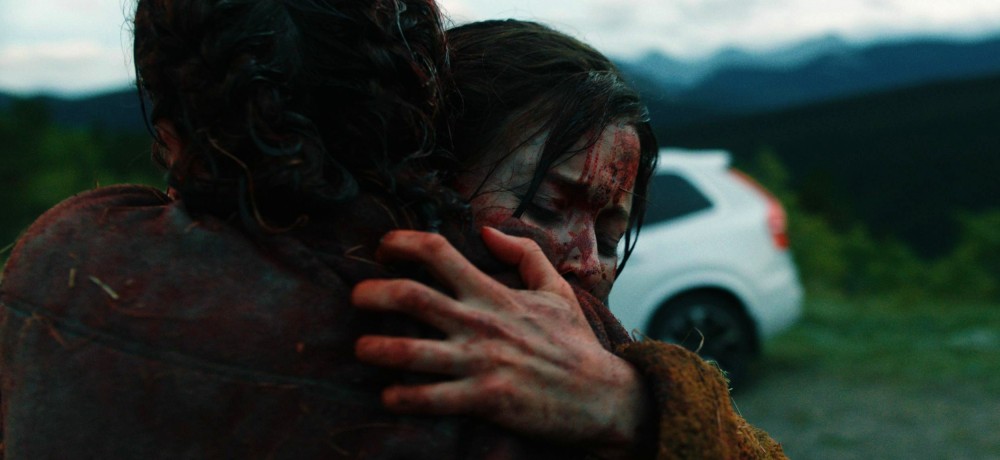


We’re seeing a lot of horror that is dealing with the effects of trauma and healing. These topics are having a rightful genre moment and are the subjects of a lot of different films. From She Will to Swallow to The Vigil and more,stories about the aftermath of trauma are very much a part of the current horror landscape. Which makes sense - we are in a place culturally where we are asking individuals and cultures as a whole to take responsibility for past wrongdoings. This moment of recognition is, in turn, offering (to various degrees of success) the victims of trauma the space and the grace to begin to heal. At least, that’s what we hope. So it’s only natural that our fiction begins to reflect these thoughts and desires as well. Berkeley Brady’s Dark Nature is a horror film that takes on these complicated needs, to varying degrees of success.
In Dark Nature, a small group of women take a therapy trip with their doctor into the Canadian wilderness. The idea is to get away from their comfort zones and put themselves in a position of vulnerability. To do something that scares them. To challenge themselves out of the space that they have built and into one that is unfamiliar, in the hope that they will be better able to confront the traumas that continue to cause them pain. Most of the women have been on these trips with Dr. Dunnley (Kyra Harper) before, but this is Joy’s (Hannah Emily Anderson) first time out. She is struggling to get past the trauma of an abusive relationship that she left six months ago. Though time has passed, the memory is fresh, and it is only at the insistence of Carmen (Madison Walsh) , her longtime friend and another member of the group, that she has agreed to try Dr. Dunnley’s process.
A day into the trip, Joy starts hearing things. She hears voices whispering and the familiar sound of a metal lighter being repeatedly opened and closed - something her ex used to do to convey his annoyance or displeasure. Though she came on this trip to leave him behind, she feels he is very much present.
She’s not the only one - other members of the group begin experiencing similar things. Strange visions, auditory hallucinations, all tied to their own pasts and traumas. They are not alone in this wilderness. Something is following them, and it understands and preys upon their fears and their horrors. Their journey shifts from being about healing to being about raw survival. Survival not only in the face of an unforgiving natural world, but of a menacing supernatural predator as well.
The film is a mixed bag in terms of character development and motivation. The only character who seems fully fleshed out is Joy. The film opens on her final night with her abusive ex, so the audience gets a good idea of what a dirtbag he is and why she should be leaving him behind. We also get a good idea of why that night was so traumatic for and continues to haunt her six months later. The rest of the cast? Not so much. The other women are painted in somewhat broad strokes, and though we get slight peeks into their backgrounds as the film goes on, we don’t really get enough to make them feel like fully developed characters.
On the flip side though, the relationship between Joy and Carmen is an interesting one. Carmen is the friend who has always had Joy’s back. The person who has supported her no matter what. She encouraged her to break with her ex when she saw the signs that the relationship was toxic, and she congratulated Joy on reaching the point of six months of freedom. But all of that comes with a cost. Carmen loves Joy, but is reaching the end of the patience that she has been providing over the years. Their relationship has reached a certain point of toxicity for her, and she is weighing how much more she can give. It’s an interesting dynamic to focus on. So often in film, we see the friend who will be there no matter what; whose love and support know no bounds. But that isn’t terribly realistic. Everyone has their limits, and that level of constant support can have its own impacts. It’s refreshing to see a relationship built on support that isn’t so one-sided.
There are some interesting threads that are teased throughout the story that provide food for thought, though don’t wind up becoming fully fleshed out. The Indiginous history of the mountains they are climbing and the role that colonialism played in this area being abandoned and forgotten, for one. Another focuses on the potential danger Dr. Dunnley put them all in by not being terribly familiar with the area and playing the whole trip a little more hippy and a little less survival expert. All interesting supporting themes that don’t get the full attention of the story.
What we do focus on is the entity stalking them through the mountains. Brady does a good job at keeping her creature well hidden until the final act. Much of what Joy and the others see among the trees is told to us. We really don’t see anything early on, and as the creature begins to make its presence more known, we only get the occasional glimpse until Brady is ready for us to see it and take it all in. The creature design is great and the slow reveal is very effective.
Ultimately, Joy is forced to face her trauma in a way that does more than ask her to move past it. She faces it down in a life or death scenario. It’s probably more than she bargained for when she agreed to go on this trip, but it is no less deserved.
Movie Score: 3.5/5